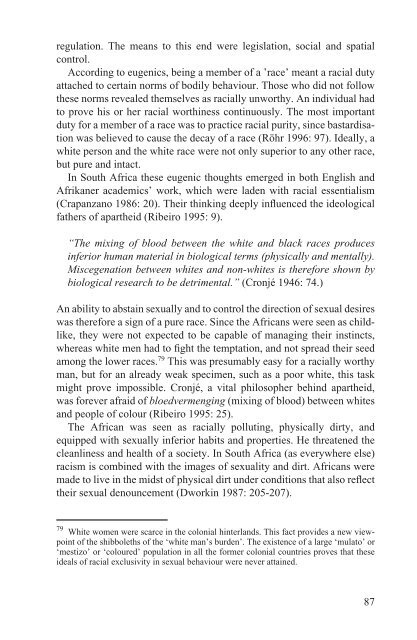The Making of a Good White - E-thesis - Helsinki.fi
The Making of a Good White - E-thesis - Helsinki.fi
The Making of a Good White - E-thesis - Helsinki.fi
Create successful ePaper yourself
Turn your PDF publications into a flip-book with our unique Google optimized e-Paper software.
egulation. <strong>The</strong> means to this end were legislation, social and spatial<br />
control.<br />
According to eugenics, being a member <strong>of</strong> a ’race’ meant a racial duty<br />
attached to certain norms <strong>of</strong> bodily behaviour. Those who did not follow<br />
these norms revealed themselves as racially unworthy. An individual had<br />
to prove his or her racial worthiness continuously. <strong>The</strong> most important<br />
duty for a member <strong>of</strong> a race was to practice racial purity, since bastardisation<br />
was believed to cause the decay <strong>of</strong> a race (Röhr 1996: 97). Ideally, a<br />
white person and the white race were not only superior to any other race,<br />
but pure and intact.<br />
In South Africa these eugenic thoughts emerged in both English and<br />
Afrikaner academics’ work, which were laden with racial essentialism<br />
(Crapanzano 1986: 20). <strong>The</strong>ir thinking deeply influenced the ideological<br />
fathers <strong>of</strong> apartheid (Ribeiro 1995: 9).<br />
“<strong>The</strong> mixing <strong>of</strong> blood between the white and black races produces<br />
inferior human material in biological terms (physically and mentally).<br />
Miscegenation between whites and non-whites is therefore shown by<br />
biological research to be detrimental.” (Cronjé 1946: 74.)<br />
An ability to abstain sexually and to control the direction <strong>of</strong> sexual desires<br />
was therefore a sign <strong>of</strong> a pure race. Since the Africans were seen as childlike,<br />
they were not expected to be capable <strong>of</strong> managing their instincts,<br />
whereas white men had to <strong>fi</strong>ght the temptation, and not spread their seed<br />
among the lower races. 79 This was presumably easy for a racially worthy<br />
man, but for an already weak specimen, such as a poor white, this task<br />
might prove impossible. Cronjé, a vital philosopher behind apartheid,<br />
was forever afraid <strong>of</strong> bloedvermenging (mixing <strong>of</strong> blood) between whites<br />
and people <strong>of</strong> colour (Ribeiro 1995: 25).<br />
<strong>The</strong> African was seen as racially polluting, physically dirty, and<br />
equipped with sexually inferior habits and properties. He threatened the<br />
cleanliness and health <strong>of</strong> a society. In South Africa (as everywhere else)<br />
racism is combined with the images <strong>of</strong> sexuality and dirt. Africans were<br />
made to live in the midst <strong>of</strong> physical dirt under conditions that also reflect<br />
their sexual denouncement (Dworkin 1987: 205-207).<br />
79 <strong>White</strong> women were scarce in the colonial hinterlands. This fact provides a new viewpoint<br />
<strong>of</strong> the shibboleths <strong>of</strong> the ‘white man’s burden’. <strong>The</strong> existence <strong>of</strong> a large ‘mulato’ or<br />
‘mestizo’ or ‘coloured’ population in all the former colonial countries proves that these<br />
ideals <strong>of</strong> racial exclusivity in sexual behaviour were never attained.<br />
87
















